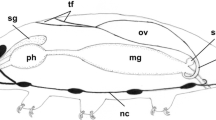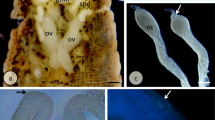Summary
In the ovary of Chironomus during phase 1 of the fourth larval instar, polygonally flattened “inner cells” are surrounded by smaller “outer cells” which contain bacteroids and phagosomes. Irregular cell remnants (“germ line accompanying substances”) lie among the inner cells. At the beginning of ovariole formation in phase 3, two layers of outer cells are separated by the formation of fissures. The inner layer of these cells (follicle- and egg-passage epithelium) forms regular invaginations. Cell pairs, identified as oocytes and nurse cells by “synaptic complexes” or multiple chromatin structures, wander from inside into the invaginations. Frequently between the two cells are fusomes, which later close in a characteristic manner. During phase 5, an egg passage is formed as a fissure among the egg-passage cells. During phase 7, the egg passage cells are conspicuously full of glycogen. Shortly before vitellogenesis membrane systems and annulated lamellae appear in the region of the oocyte. Accessory nuclei are formed by a “tieing-off” of projections of the the oocyte nucleus. During phase 9, microvilli and pinocytotic vesicles can be seen at the periphery of the oocyte. The distal cells of the ovariole are of oocyte or nurse cell nature, but in Ch. melanotus they are not surrounded by follicle cells and are reduced during further ovariole growth. In spite of the extremely small number of nurse cells in the follicle, the Chironomus ovary apparently does not differ functionally from other polytrophic meroistic insect ovaries.
Zusammenfassung
Im Ovar von Chironomus sind in Phase 1 des 4. Larvenstadiums polygonal abgeflachte „Innenzellen“ von kleineren „Außenzellen“ umgeben, die Bakteroide und Phagosomen enthalten; zwischen den Innenzellen liegen unregelmäßige Zelltrümmer („keimbahnbegleitende Substanzen“). Zu Beginn der Ovariolenbildung werden in Phase 3 durch Spalträume zwei Schichten der Außenzellen voneinander getrennt, von denen die innere (Follikel- und Eikanalepithel) regelmäßige Buchten bildet. In diese Buchten wandern von innen Zellpaare ein, die an „synaptischen Komplexen“ bzw. multiplen Chromatinstrukturen als Ei- und Nährzellen kenntlich sind. Zwischen beiden Zellen sind „Fusome“ häufig, die später in eigentümlicher Weise geschlossen werden. Zwischen den Eikanalzellen entsteht in Phase 5 durch Spaltbildung der Eikanal; in Phase 7 sind die Eikanalzellen auffallend glykogenreich. Kurz vor der Vitellogenese treten im Bereich der Oocyte Membransysteme und „annulated lamellae“ auf; akzessorische Kerne werden als Ausstülpungen des Oocytenkernes gebildet und später abgeschnürt. In Phase 9 sind an der Peripherie der Eizelle Mikrovillisäume und Pinocytosebläschen sichtbar. Die distalen Zellen der Ovariole haben Eioder Nährzellcharakter, sind aber bei Ch. melanotus nicht von Follikelzellen umgeben und werden beim weiteren Ovariolenwachstum reduziert. Trotz extrem geringer Nährzellzahl der Follikel scheint das Chironomus-Ovar funktionell nicht von anderen polytroph meroistischen Insektenovarien unterschieden.
Similar content being viewed by others
Literatur
Abul-Nasr, S. E.: Structure and development of the reproductive system of some species of Nematocera (Diptera). Phil. Trans. roy. Soc. B 234, 339–396 (1950).
Anderson, E.: Oocyte differentiation and vitellogenesis in the roach Periplaneta americana. J. Cell Biol. 20, 131–155 (1964).
Bier, K.: Oogenese, das Wachstum von Riesenzellen. Naturwissenschaften 54, 189–195 (1967).
— Kunz, W., Ribbert, D.: Struktur und Funktion der Oocyten-Chromosomen und Nucleolen sowie der Extra-DNS während der Oogenese panoistischer und meroistischer Insekten. Chromosoma (Berl.) 23, 214–254 (1967).
— Ramamurty, P. S.: Elektronenoptische Untersuchungen zur Einlagerung der Dotterproteine in der Oocyte. Naturwissenschaften 51, 223–224 (1964).
Brauns, F.: Die Entstehung der Nährzelle und die Bedeutung derselben für das wachsende Ei bei Forficula auricularia L. S.-B. Abh. naturforsch. Ges. Rostock, N. F. 4, 99–141 (1912).
Bush, G. L., Chapman, G. B.: Electron microscopy of symbiotic bacteria in developing oocytes of the american cockroach Periplaneta americana. J. Bact. 81, 267–276 (1961).
Clements, A. N.: The physiology of mosquitoes. Oxford: Pergamon Press 1963.
Detinova, T. S.: Physiological changes in the ovaries of female Anopheles maculipennis. Med. Parasit. Moskow 18, 410–420 (1949).
Engels, W.: Geschwindigkeit des RNS-Transports im Einährverband der Dermapteren im Vergleich mit anderen Insekten meroistischen Ovartyps. Zool. Anz., Suppl. 33 (1970) (im Druck).
— Bier, K.: Zur Glykogenspeicherung während der Oogenese und ihrer vorzeitigen Auslösung durch Blockierung der RNS-Versorgung (Untersuchungen an Musca domestica L.). Wilhelm Roux' Arch. Entwickl.-Mech. Org. 158, 64–88 (1967).
Fischer, J.: Zur Fortpflanzungsbiologie von Chironomus nuditarsis Str. Rev. suisse Zool. 16, 23–55 (1969).
Franchi, L. L., Mandl, A. M.: The ultrastructure of oogonia and oocytes in the foetal and neonatal rat. Proc. roy. Soc. B 157, 99–114 (1963).
Grimm, O. v.: Die ungeschlechtliche Fortpflanzung einer Chironomusart und deren Entwicklung aus dem unbefruchteten Ei. Mem. Acad. Imp. Sci. St. Petersburg, Ser. VII 15, 1–24 (1870).
Hopkins, C. R.: The histochemistry and fine structure of the accessory nuclei in the oocyte of Bombus terrestris. Quart. J. micr. Sci. 105, 457–480 (1964).
Hosoi, T.: Egg production in Culex pipiens pallens Coquillet III. Growth and degeneration of ovarian follicles. Jap. J. med. Sci. Biol. 7, 111–127 (1954).
Kessel, R. G., Beams, H. W.: Micropinocytosis and yolk formation in oocytes of the small milk weed bug. Exp. Cell Res. 30, 440–443 (1963).
King, R. C., Aggarwal, S. K., Aggarwal, U.: The development of the female Drosophila reproductive system. J. Morph. 124, 143–166 (1968).
—, Devine, R. L.: Oogenesis in adult Drosophila. VII. The submicroscopic morphology of the ovary. Growth 22, 299–326 (1958).
Koch, E. A., King, R. C.: The origin and early differentiation of the egg chamber of Drosophila melanogaster. J. Morph. 119, 283–304 (1966).
Korscheit, E.: Beiträge zur Morphologie und Physiologie des Zellkerns, Zool. Jb., Abt. Anat. Ontog. 4 (1889).
Meyer, G. F.: Intrazellulare Brücken (Fusome) im Hoden und im Ei-Nährzellverband von Drosophila melanogaster. Z. Zellforsch. 54, 238–251 (1961).
Miall, L. C., Hammond, A. R.: The structure and life history of the Harlequin-fly (Chironomus). Oxford: Clarendon Press 1900.
Milburn, N. S.: Fine structure of the pleomorphic bacteroides in the mycetocytes and ovaries of several genera of cockroaches. J. Ins. Physiol. 12, 1245–1254 (1966).
Nicholson, A. J.: The development of the ovary and ovarian egg of a mosquito, Anopheles maculipennis Meig. Quart. J. micr. Sci. 65, 395–448 (1921).
Nørrevang, A.: Electron microscopic morphology of oogenesis. Int. Rev. Cytol. 23, 113–186 (1968).
Okada, M.: Fine structure of pole cells and polar plasma in Chironomus dorsalis. Sci. Dep. Tokyo Kyoiku Dagaiku 13, 175–182 (1967).
Oliver, D. R.: Adaptation of arctic Chironomidae. Ann. Zool. Fenn. 5, 111–118 (1968).
Overton, J., Raab, M.: The development and fine structure of centrifuged eggs of Chironomus thummi. Develop. Biol. 15, 271–287 (1967).
Roth, T. F., Porter, K. R.: Yolk protein uptake in the oocyte of the mosquito Aedes aegypti L. J. Cell Biol. 20, 313–332 (1964).
Sachtleben, H.: Über die Entwicklung der Geschlechtsorgane von Chironomus mit besonderer Berücksichtigung der keimbahnbegleitenden Substanzen. Diss. Univ. München (1918).
Sitte, P.: Bau und Feinbau der Pflanzenzelle. Stuttgart: Gustav Fischer 1965.
Stay, B.: Protein uptake in the oocytes of the cecropia moth. J. Cell Biol. 26, 49–62 (1965).
Tahmisian, T. N., Devine, R. L., Wright, B. J.: The ultrastructure of the plasma membrane at the division furrow of grasshopper germ cells. Z. Zellforsch. 77, 316–324 (1967).
Wensler, R. J. D., Rempel, J. G.: The morphology of the male and female reproductive system of the midge Chironomus plumosus L. Canad. J. Zool. 40, 199–229 (1962).
Wright, K. A., Jones, N. O.: Some techniques for the orientation and embedding of nematodes for electron microscopy. Nematologica (Leiden) 11, 125–130 (1965).
Wülker, W.: Untersuchungen üher die Intersexualität der Chironomiden nach Paramermis-Infektion. Arch. Hydrobiol., Suppl. 25, 127–181 (1961).
— Götz, P.: Die Verwendung der Imaginalscheihen zur Bestimmung des Entwicklungszustandes von Chironomus-Larven. Z. Morph. Tiere 62, 363–388 (1968).
Author information
Authors and Affiliations
Additional information
Mit Unterstützung durch die Deutsche Forschungsgemeinschaft.
Rights and permissions
About this article
Cite this article
Wülker, W., Winter, G. Untersuchungen über die Ultrastruktur der Gonaden von Chironomus (Dipt.). Z. Zellforsch. 106, 348–370 (1970). https://doi.org/10.1007/BF00335778
Received:
Issue Date:
DOI: https://doi.org/10.1007/BF00335778




